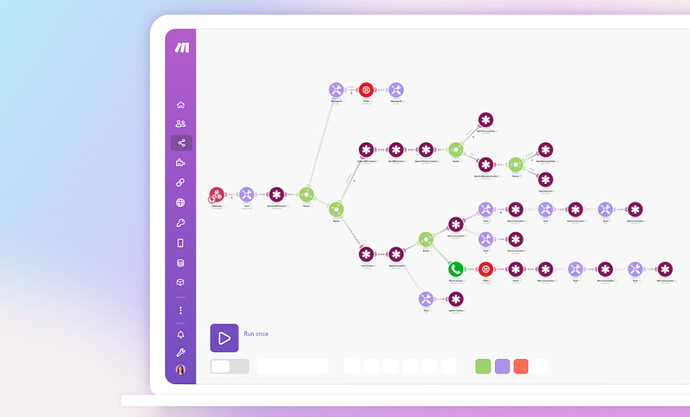Hey Makers
Happy groundhog day
We’ve got a great story to share with you on this fine afternoon.
Sit back, grab a cup of tea or coffee, and give it a read!
![]() We love hearing about the ways our Community members are saving time and boosting ROI, but we are especially proud when Make solutions have a direct impact on people’s lives – especially children’s.
We love hearing about the ways our Community members are saving time and boosting ROI, but we are especially proud when Make solutions have a direct impact on people’s lives – especially children’s.
That’s why we’d love you to meet Project Lifelong: A Sacramento, California-based non-profit that empowers youth through experiential-based programming. It connects kids to a variety of after-school programs that instill values like leadership, good health, and general well-being.
![]()
![]() The onset of the pandemic, and the lack of in-person interaction that came with it, meant that many young people experienced gaps in their education and learning, social isolation, and mental health issues. As if those weren’t tough enough, still another challenge was the breakdown in critical communication between students, parents, schools, and after-school programs.
The onset of the pandemic, and the lack of in-person interaction that came with it, meant that many young people experienced gaps in their education and learning, social isolation, and mental health issues. As if those weren’t tough enough, still another challenge was the breakdown in critical communication between students, parents, schools, and after-school programs.
Project Lifelong realized as the pandemic eased that students and their families were in need of support when it came to integrating back into school communities, and a personalized texting app was the missing component.
![]() Michael Saigon, founder of Project Lifelong and a former youth officer for the Sacramento County Sheriff’s department, joined forces with automation hero @andyoneil the founder of Weblytica, to develop a solution.
Michael Saigon, founder of Project Lifelong and a former youth officer for the Sacramento County Sheriff’s department, joined forces with automation hero @andyoneil the founder of Weblytica, to develop a solution.
Andy’s custom solution combines Make, Twilio, and Knack (a no-code application development tool), and allows schools, parents, and programs to share information ranging from emergency response notifications to program updates and general questions in a streamlined way.
![]() Keep reading for the full story
Keep reading for the full story
What problem were you trying to solve with your automation?
The problem was coming out of Covid and an increasingly online, digitized world, where there is less face-to-face communication. We had to create a more personalized communications texting program so the parents felt more connected day to day to the students and the community.
Why did the problem exist?
There were no out-of-the-box solutions that could be customized using Make’s ability to create dynamic filters so that e.g. parents only received one message even if they had 3 kids in the program.
With Make and access to Knack’s API, we were able to integrate texting functionality using Twilio. Make offered the ability to build in some protections (cue process adding students to the data store and then a second automation that sent an email/SMS campaign to the parents). This helped prevent automation errors and double-sending to constituents.
Overall, the personalized, two-way communication bridges the gap that was left when the face-to-face interaction of handling paper forms was eliminated. The new texting capability enables both individual and group messaging to cover emergency response notifications, program updates, or general questions.
Without Knack’s API, we would have had to use multiple tools, which would have been both costly and time-consuming to manage.
What was the scope of the entire problem?
The scope was approximately
- 20+ recurring after-school programs
- 600+ students and their parents
- the programs were executed over 100s of hours.
The scope of the problem also extended to the new texting capability which enables both individual and group messaging to cover emergency response notifications, program updates or general questions.
Building off the member data management system, we created a set of interconnected apps. The linkage means they share core membership data, making the solution easy to scale because there’s no need to manually enter data again for a new app.
This build-once model speeds up the process of adding new functionality.
“Now it’s much more than a place where parents sign up for a program. We’ve got a referral intake, a case management component, recording for accident or info reports, and now a communication component,” explained Michael, founder of Project Lifelong. “And they all work together.”
The referral intake system specifically offered a powerful community level diversion program for parents who are in crisis mode. Parents, social workers, mental health professionals, and law enforcement can each access the system and input information to refer kids who need help.
What does the solution look like?
- The Knack no code application eliminated the need for paper documents and manual data entry, allowing parents to submit program applications, input and update emergency contact information, and sign forms.
- An email and/or SMS campaign is generated from a Knack application that targets the parents of a specific high school program.
- Make searches the relevant parent or secondary contact records, then de-dupes them, and creates a queue in the Make data store.
- Then a second automation is triggered that sends the campaign via email/sms.
- All sent campaigns and the results of personalized messages are saved in a live Knack communications dashboard.
- Twilio offers the delivery status and which is saved in the dashboard to highlight if any important communications are going undelivered (to a landline etc).
What did your solution achieve?
- Improved personalized communications and targeting
- Stronger relationships are built by providing positive role models and creating one-of-a-kind experiences that are truly changing the life trajectories of the students served.

